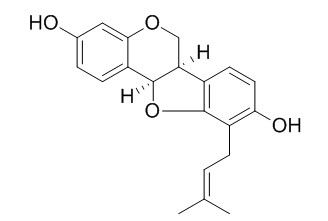Phaseollidin
Phaseollidin, a phytoalexin from Phaseolus vulgaris, has antimicrobial activity. It also has anti-anxiety properties.
Inquire / Order:
manager@chemfaces.com
Technical Inquiries:
service@chemfaces.com
Tel:
+86-27-84237783
Fax:
+86-27-84254680
Address:
1 Building, No. 83, CheCheng Rd., Wuhan Economic and Technological Development Zone, Wuhan, Hubei 430056, PRC
Providing storage is as stated on the product vial and the vial is kept tightly sealed, the product can be stored for up to
24 months(2-8C).
Wherever possible, you should prepare and use solutions on the same day. However, if you need to make up stock solutions in advance, we recommend that you store the solution as aliquots in tightly sealed vials at -20C. Generally, these will be useable for up to two weeks. Before use, and prior to opening the vial we recommend that you allow your product to equilibrate to room temperature for at least 1 hour.
Need more advice on solubility, usage and handling? Please email to: service@chemfaces.com
The packaging of the product may have turned upside down during transportation, resulting in the natural compounds adhering to the neck or cap of the vial. take the vial out of its packaging and gently shake to let the compounds fall to the bottom of the vial. for liquid products, centrifuge at 200-500 RPM to gather the liquid at the bottom of the vial. try to avoid loss or contamination during handling.
Cell Death Dis.2019, 10(12):882
Cells.2021, 10(10):2633.
Food Science.2023, 4(20):268-282.
Heliyon.2023, e12778.
Indian J Pharm Sci.2022, 84(4): 874-882.
Phytochem Anal.2024, pca.3319.
Curr Res Virol Sci.2022, 3:100019.
Microb Pathog.2024, 189:106609.
China Pharmacy2015, 26(27)
Kor. J. Pharmacogn.2016, 47(1):62-72
Related and Featured Products
FEMS Microbiol Lett. 1992 Jul 1;73(1-2):187-90.
An extracellular enzyme from Fusarium solani f. sp. phaseoli which catalyses hydration of the isoflavonoid phytoalexin, phaseollidin.[Pubmed:
1521768]
Among the antimicrobial phytoalexins produced by Phaseolus vulgaris (French bean) are the prenylated isoflavonoids kievitone and Phaseollidin.
METHODS AND RESULTS:
Two enzyme activities, kievitone hydratase and Phaseollidin hydratase, occur in culture filtrates of the bean pathogen, Fusarium solani f. sp. phaseoli, and catalyse similar hydration reactions on the dimethylallyl moieties of the phytoalexins. The enzymes nearly co-purified during hydroxyapatite chromatography followed by preparative native gel electrophoresis. Eluates from successive slices taken from the native gel were assayed for both activities.
CONCLUSIONS:
Although they were not completely separated in the native gel, the activity profiles indicated that the two activities were distinct. The Km of Phaseollidin hydratase for Phaseollidin was approximately 7 microM.
Aust. J. Chem., 1974, 27(27):1607-11.
Phaseollidin, a Phytoalexin From Phaseolus vulgaris: Isolation, Physicochemical Properties and Antifungal Activity[Reference:
WebLink]
METHODS AND RESULTS:
The isolation of Phaseollidin from diffusates of fungal-inoculated fruits of Phaseolus vulgaris is described. Physicochemical and antifungal properties of this compound are reported.
World J. Pharm .Sci., 2015; 3(9): 1763-75.
Study of the Anti-Anxiety Properties of the Phaseollidin, An Isoflavonoid Isolated from Erythrina droogmansiana (Leguminosae)[Reference:
WebLink]
The anti-anxiety properties of the Phaseollidin, isoflavonoid isolated from Erythrina droogmansiana, were studied in the white mice.
METHODS AND RESULTS:
Various experimental models (Elevated Plus-Maze, Open-Field, Hole-Board, Hyperthermia Induced Stress), were used to highlight these properties. The results showed that the Phaseollidin involved a significant increase of the time spent in the open arms of the raised labyrinth in cross, with 97.8 � 21.64 seconds for a dose of 50 mg/kg and 115.4 � 34.03 seconds for the dose 25 mg/kg. These results thus testify to the fall of the aversion of the rodents for enlightened spaces. In the tests of the hole-board and open-field, used to evaluate the exploration and locomotion activities of mice, the results showed a significant increase of the locomotion (crossing) with 42.2 � 10.30 for the dose 25 mg/kg and 60 � 9.05 for the dose 100 mg/kg of the Phaseollidin. The doses 25 mg/kg and 100 mg/kg of the Phaseollidin also showed a significant increase of �rearing�.
CONCLUSIONS:
These results show that the Phaseollidin has anti-anxiety properties.



